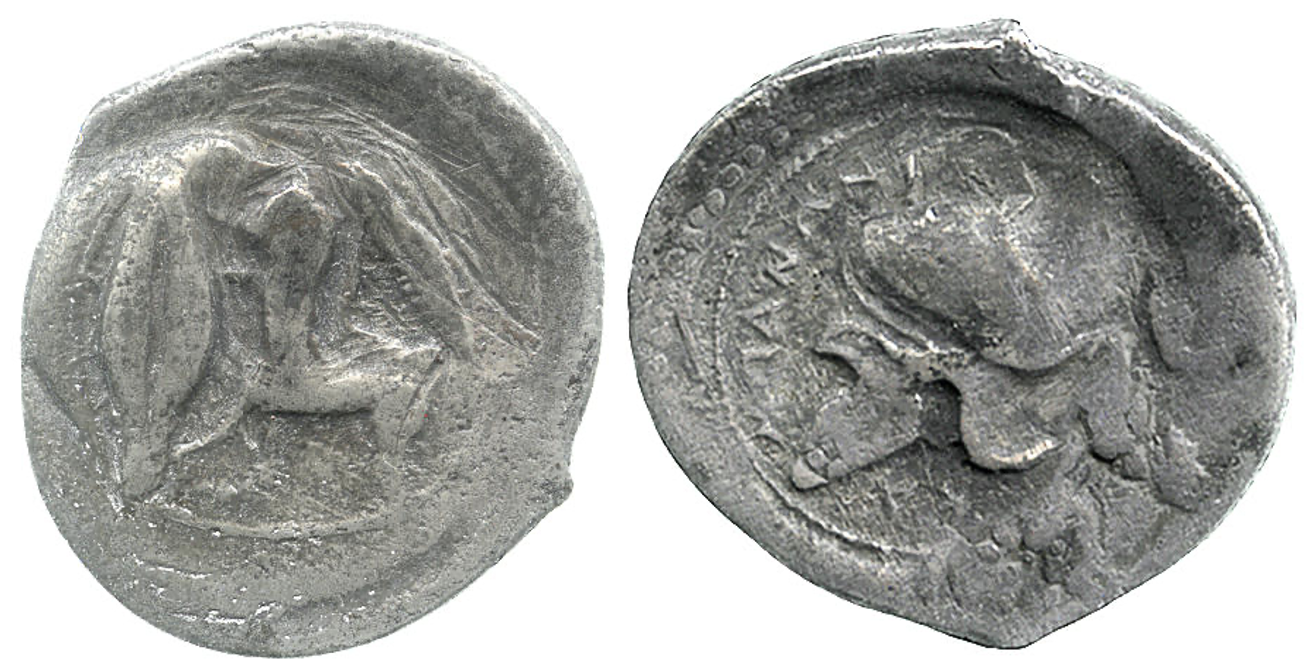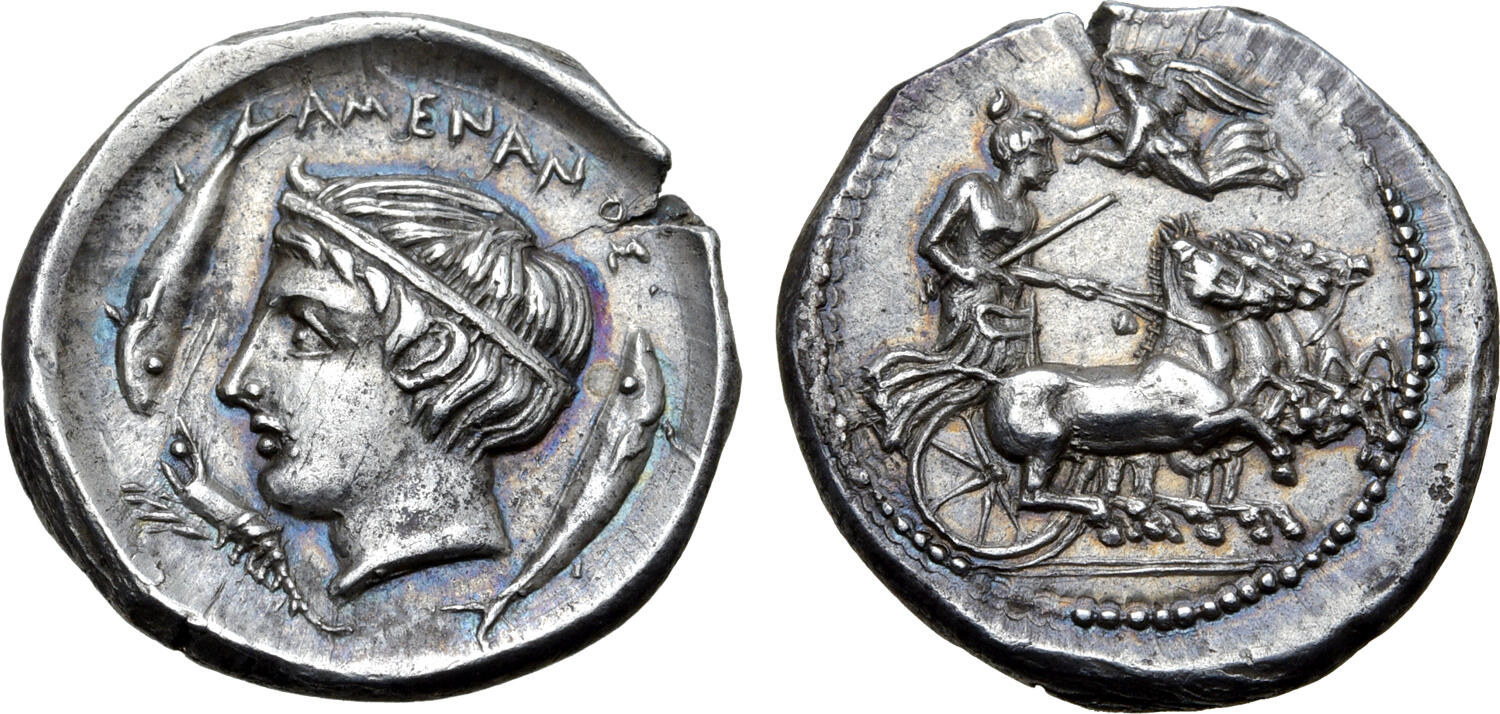410 BCE - 368 BCE | KAMΠΑΝΩΝ
Overstriking coin
SO_119_-_Entella_(drachm)_over_Catana.png
[1]
Overstruck variety
Catana Quadriga Apollo drachm.jpg
[2]
Description
| ObverseInscription or printing placed on the obverse.:
|
Horse galloping right, over corn grain.
|
ReverseInscription or printing placed on the reverse.:
|
KAMΠΑΝΩΝ (Greek) Campanian helmet left.
|
Mint and issuing power
| MintIdentifies the place of manufacture or issue of a numismatic object.:
|
Entella
|
Ancient regionAncient region.
|
Sicily
|
Modern countryModern country: Italy
|
AuthorityIdentifies the issuing power. The authority can be "pretended" when the name or the portrait of X is on the coin but he/she was not the issuing power. It can also be "uncertain" when there is no mention of X on the coin but he/she was the issuing power according to the historical sources:
|
|
Chronology
| FromIdentifies the initial date in a range assigned in a numismatic context. 410 BCE toIdentifies the final date in a range assigned in a numismatic context.. 368 BCE
|
Classical 480-323 BC  periodTime period of the numismatic object. periodTime period of the numismatic object.
|
Physical description
MetalThe physical material (usually metal) from which an object is made.: Silver 
|
WeightWeight of the numismatic object (in grams). in grams: 3.863.86 g <br />3,860 mg <br />
|
DenominationTerm indicating the value of a numismatic object. Examples: tetradrachm, chalkous, denarius.: drachma 
|
|
|
|
StandardStandard.: Attic
|
References
| Coin referenceReference of the Coin:
|
Noe 1957, p. 13-42, pl. V-XIV (group IX, p. 37, pl. XIII, c - wrong picture: 2231), Grose 1979, p. 262, n° 2231 and pl. 72, n° 4, Garraffo 1984, p. 133, n° b, pl. XVI, 15
|
Coin series referenceReference to coin series study:
|
Noe 19571Noe 1957, p. 13-42, pl. V-XIV (group IX, p. 37, pl. XIII, c, Garraffo 19842Garraffo 1984, p. 133, n° b, pl. XVI, 15, Lee 20003Lee 2000, n° 1-7, HGC 24HGC 2, n° 243
|
| Coin series web referenceCoin series web references:
|
|
Description
| ObverseInscription or printing placed on the obverse.:
|
Female charioteer, holding kentron and reins, driving galloping quadriga to right, above, Nike flying to left, crowning charioteer with wreath held in outstretched arms
|
ReverseInscription or printing placed on the reverse.:
|
AMENANOΣ above (Greek) Horned head of the river-god Amenanos to left, wearing tainia, crayfish and two dolphins around
|
Mint and issuing power
| MintIdentifies the place of manufacture or issue of a numismatic object. ᵖ:
|
Catana
|
Ancient regionAncient region. ᵖ
|
Sicily
|
Modern countryModern country: Italy
|
AuthorityIdentifies the authority in whose name (explicitly or implicitly) a numismatic object was issued. ᵖ:
|
|
Chronology
| FromIdentifies the initial date in a range assigned in a numismatic context. 405 BCE toIdentifies the final date in a range assigned in a numismatic context.. 403 BCE
|
Classical 480-323 BC  periodTime period of the numismatic object. periodTime period of the numismatic object.
|
Physical description
| DenominationTerm indicating the value of a numismatic object. Examples: tetradrachm, chalkous, denarius. ᵖ:
|
drachma 
|
|
|
References
References
- ^ Noe, Sydney P. (1957), "Overstrikes in Magna Graecia", American Numismatic Society. Museum Notes 7, p. 13-42, pl. 5-14.
- ^ Garraffo, Salvatore (1984), Le riconiazioni in Magna Grecia e in Sicilia. Emissioni argentee dal VI al IV secolo a.C., Catania.
- ^ Lee, Ian (2000), "Entella: The Silver Coinage of the Campanian Mercenaries and the Site of the First Carthaginian Mint 410-409 BC", Numismatic Chronicle, 160, p. 1-66, pl. 1-3.
- a b Hoover, Oliver D. (2012), The Handbook of Greek Coinage Series. 2. Handbook of the Coins of Sicily (Including Lipara). Civic, Royal, Siculo-Punic, and Romano-Sicilian Issues. Sixth to First Centuries BC, Lancaster-London, 489 p.

